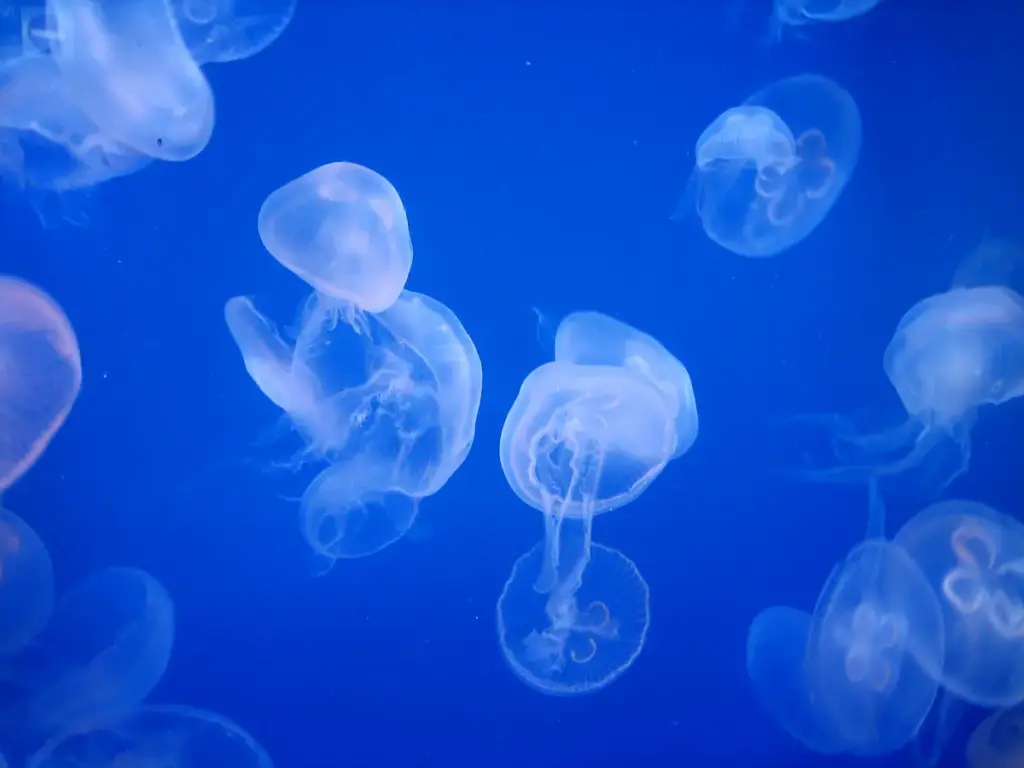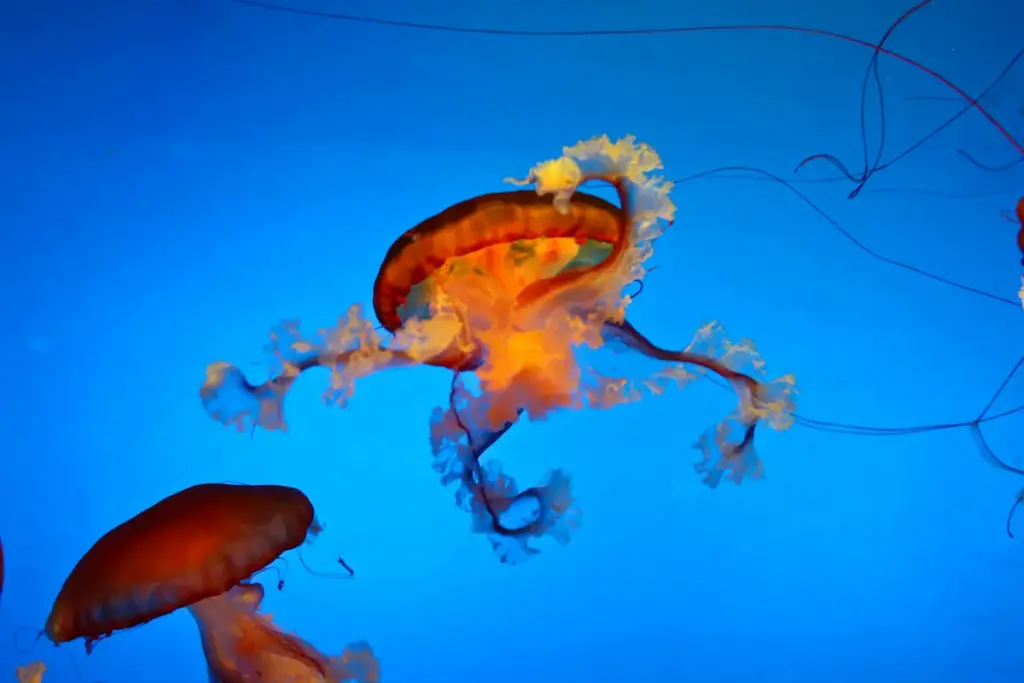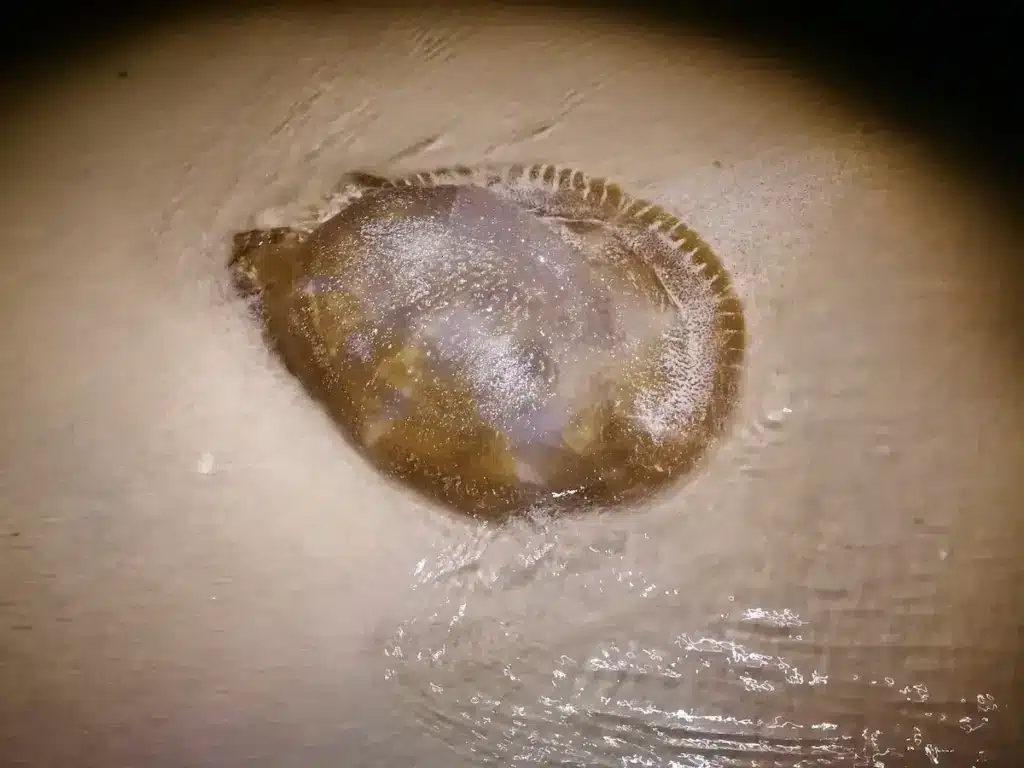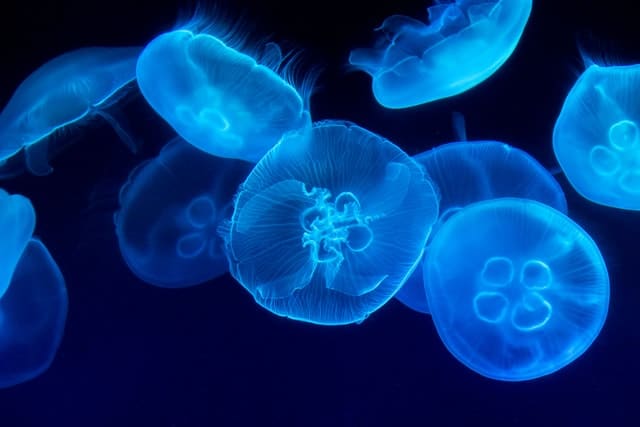Jellyfish captivate us with their translucent, gently pulsing forms, hovering like aliens as they glide through vibrant ocean waters across the globe. These ancient creatures assume critical ecological roles and evolutionary niches we are only just beginning to unravel.
This expansive article will dive deep into the biology, behavior, environmental impacts, biotechnical promise, and future trajectories of mysterious jellyfish spanning over 500 million years since the Cambrian evolutionary explosion.

What Are Jellyfish?
Jellyfish taxonomically belong to the Cnidaria phylum, one of the earliest animal groups to diverge over 540 million years ago. Cnidarians also contain corals, sea anemones and marine hydrozoans. The name “jellyfish” generically refers to over 2,000 diverse gelatinous marine species under this ancient animal lineage sharing common traits like stinging cells and two-part life cycles.
Despite the name evoking fish, jellyfish are not vertebrates at all. Instead, “jellyfish” describes their gelatinous, mostly water bodies that provide structure from a collagen-rich, extracellular mesoglea matrix sandwiched between outer epidermal and inner gastrodermal tissue layers. This fundamental body plan with radial symmetry supports specialized structures aiding a drifting, predatory existence.
External Anatomy
The external bell or umbrella-shaped dome functions like a pulsating propulsion chamber. Rhythmic contractions squeeze fluid out the opening for jet-propelled locomotion. Oral arms under the smooth bell direct food inside while dangling tentacles armed with stinging cells trap prey.
Sophisticated rhopalia structures resembling bushes of grapes festooning the bell rim harbor advanced sensory receptors guiding navigation toward nutrients or away from threats detected in surrounding waters.
Internal Structure
A central mouth opens into the gastrovascular cavity lined with gastrodermal cells, releasing digestive enzymes to absorb nutrients from decomposing prey floating in this compartment almost like an external stomach. Fluid currents generated by ciliary beating direct nutrients throughout tissues.
A distinct gastric pouch stores undigested waste ultimately expelled through the same central mouth. Four horseshoe-shaped gonads surround the gastrodermal lining, releasing eggs and sperm during seasonal spawning events to eject through pores around the oral arms.
While diverse, most jellyfish share this general organizational blueprint and toolkit promoting ecological success across changing marine habitats over hundreds of millions of years from primordial oceans to current seas. Next, we survey amazing jellyfish diversity before delving into their complex life histories.

Taxonomic Diversity
Remarkably diverse jellyfish species populate all oceans. More than 2,000 identified types drift through tropical to arctic waters, ranging in sizes from a nearly microscopic Irukandji jellyfish with bells smaller than a fingernail up to the Giant Nomura’s jellyfish with six-foot-wide bells weighing 450 pounds. Most fall into a few major taxonomic groups.
- Scyphozoans – This class contains the larger jellyfish varieties that are more familiar to beachgoers, like the moon jellyfish (Aurelia). With rounded bells and long dangling oral arms and tentacles, scyphozoan jellyfish resemble colorful gooey umbrellas pulsing through the seas.
- Cubozoans – Typically called box jellyfish for their boxy, cubic bells, these aggressive invertebrates include the dangerous Chironex sea wasp responsible for the world’s most potent marine venoms delivered through clusters of 60 tentacles studded with 5 million stinging cells apiece. Just brushing certain cubozoans can require life-saving medical attention.
- Staurozoans – These bizarre sessile jellyfish resemble extraterrestrial lifeforms, anchored by slender stalks to rocks and seaweeds instead of drifting through currents. When small crustaceans or fish larvae inadvertently brush against their 12–16 arms, staurozoans respond by clutching prey with surrounding muscles until they can be transferred to the central mouth for ingestion.
- Hydrozoans – This highly diverse order encompasses tiny hydromedusae species with short tentacles that easily escape notice near the surface while preying on plankton. It also includes siphonophores like the Portuguese man o’ war, with colonies of specialized zooids acting together as one cohesive drifting organism.
Despite variety across roughly 200 jellyfish families, their shared baseline body architecture endows resilience, allowing jellyfish to expand across aquatic habitats as conditions change over time. Now, we explore the convoluted life cycle underlying such prosperity.
Complex Jellyfish Life Cycle
Jellyfish exhibit a complex metagenic life history alternating between planktonic medusoid and benthic polypoid phases attaching to solid substrates. Each stage serves necessary functions toward proliferation.
The familiar drifting jellyfish filling seas by season comprise the medusae stage. These mature adults reproduce sexually, with males releasing sperm to internally fertilize eggs within females. Fertilized eggs develop into larvae that search out hard surfaces across the seafloor to irreversibly anchor onto using cellular glues. Attached larvae grow into frilly stalked structures called polyps resembling miniature sea anemones.
Polyps reproduce asexually by cloning out large batches of genetically identical juvenile medusae in a process called strobilation. The pre-medusae nodes bud off the polyp over days to weeks, depending on the species. These tiny ephyra larvae then break away into the water column to mature toward sexually reproducing adults again.
The polyp phase lasts varying durations from months to years depending on environmental factors like temperature, light, salt levels, nutrition, and oxygenation. Polyps form calcareous tubes while cloning out numerous medusae buds until conditions enable the tiny jellies to drift to feed and mature further out at sea. When marine conditions turn inhospitable, polyps protectively cyst into hardened seedpod-like structures awaiting better times.
This alternation between asexual polyp and sexual medusoid stages with intermediary larvae allows jellyfish to populate seas from the ocean floor up toward the surface by season. When conditions align favorably, embedded polyps rapidly boost numbers through cloning.
Jellyfish thus bloom abundantly as marine environments flux, explaining their propensity to periodically dominate disturbed or degraded habitats. Next we detail the predatory diets and feeding strategies supporting these outgrowths.

Feeding Ecologies and Predation Strategies
As prolific carnivores, different jellyfish species exhibit diverse feeding strategies, from active swimming pursuits to passive plankton absorption. But most jellyfish share generalist diets, feeding opportunistically on whatever nutritive morsels flow into their trailing tentacles as they drift.
The stinging cells coating jellyfish tentacles provide essential paralytic venoms facilitating prey capture and containment. Called cnidocytes, these sophisticated nematocyst stingers houses coiled harpoon tubes loaded with toxins.
When triggered by touch chemoreceptors, pressure opens a tiny hatch at the cell tip and fires the barbed stinger arrow to inject neurotoxic compounds, subduing prey struggling in the jellyfish’s grasp. Even severed jellyfish tentacles lying on a ship deck remain dangerous, with undischarged nematocysts awaiting contact.
Typical diets comprise zooplankton like crustaceans, annelids, mollusks, and protozoa, along with various eggs, larvae, bacteria, and detritus absorbed from drifting. Several jellyfish species also actively pursue and consume larger prey, including small fish and crustaceans which are first immobilized by stinging tentacles before being transported by oral arms toward the central mouth for ingestion into the gastrovascular cavity.
Differing bell sizes and tentacle lengths facilitate specialized foraging strategies. Smaller species passively absorb whatever suspended nutrients contact their stinging outer surface. Active hunters like Sea Wasps pulse pursue fish and shrimp, guided by sophisticated eyes and odor sensors along the bell margin to chase down selections. Blooms amass thousands of individuals into gigantic, deadly curtains, capturing vast tons of biomass daily.
While adaptable to available prey sources, feeding rates vary widely based on size, metabolism, nutrition, and temperature. Still, substantial exposure from expansive drifting tentacles provides adequate generalist nutrition from dilute suspended particles. Combined with expedient venom mechanisms, predatory jellyfish successfully exploit abundant niches as drifting grazers.
This helps explain their resilience and periodic outliers as dominant species across changing marine habitats. Next, we detail specific ecological roles and environmental impacts of proliferating jellyfish.

Ecological Roles and Environmental Impacts
As both key ocean prey and predators, jellyfish interact influentially with associated species and assume shifting ecological roles within developing marine ecosystems. Tracking jelly movements provides unique insights into overall habitat stability.
- As Prey – Numerous jellyfish predators like ocean sunfish, leatherback turtles, jackfish, crustacean groups, and other jellies feed extensively on drifting jelly bodies despite their stings. Humans also harvest certain jellyfish species as traditional foods and medicines, applying pressure.
- As Predators – In turn, jellyfish significantly impact ecosystem functions and services through ravenous daily consumption of zooplankton, protozoa, eggs, larvae, juvenile fish, and commercially valued crustaceans across oceans worldwide. Voracious uncontrolled jellyfish blooms devastate both wild fisheries and aquaculture stocks by devouring eggs, larvae, and cultivated species from seas in massive quantities.
- As Competitors – By eliminating zooplankton, juveniles, and phytoplankton as prey and occupying pelagic habitats with floating bodies, unchecked expanding jellyfish growth starves out competitors across trophic levels. This fundamental restructuring cascades disrupted marine ecosystems already suffering from pollution, warming, deoxygenation, and overfishing pressures that preferentially favor jellies over more complex pelagic species.
- As Environmental Engineers – Beyond grazing marine biomass and accumulating as prey for other species, jelly falls from sinking jellyfish carcasses transport and release nutrients into the depths that nourish deep water ecosystems otherwise starved for organic materials from surface photosynthesis. Jelly mucus also transports microbes, influencing biogeochemical cycling.
Clearly, jellyfish assume shifting roles within developing ecosystems as net prey, predators, competitors, and detritivores/transporters. Tracking jellyfish provides unique insights into overall marine system functionality and health. Their fluctuating population numbers broadly indicate changing ocean states caused by anthropogenic and climatic impacts.
Quantifying these disturbance responses across habitats and food webs remains an urgent research priority with ecosystem services implications. Next, we detail the evolutionary toolkit explaining 500 million years of jellyfish prosperity.
Evolutionary Adaptations and Success Factors
Jellyfish represent venerable survivors across the broader evolutionary history of animal life on Earth. Since first diversifying in early Cambrian oceans over 540 million years ago alongside other foundational complex marine phyla, jellyfish persisted through massive climate shifts and extinction events that eliminated many formidable groups.
Now, just four lineages remain from over 200 ancestral forms. What core adaptations facilitated such longevity in the seas through geological ages of upheaval?
Their radical body plan simplicity masks sophisticated evolutionary innovation:
- Extreme Biological Durability– With dispersed nervous and sensory systems not concentrated into one vulnerable head region, no centralized organs or vasculature to rupture, and extraordinary powers of regeneration from surviving cell groups, jellyfish tolerate fluctuating conditions, excluding more complex pelagic species. Missing advanced physiological systems is an actual advantage when habitats degrade chaotically.
- Radial Symmetry– Lacking anterior-posterior polarity enhances feeding, respiration, locomotion, protection, and reproduction equally well in all directions. With no definite front, back, or sides, free-floating jellies respond uniformly to nutrients or predators approaching from any angle. This maximizes ecological opportunities from all vectors.
- Regenerative & Redifferentiation Capacities – Extraordinary powers to regrow damaged body parts rapidly make jellyfish essentially immortal. Some even differentiate new organism copies from scattered residual cell masses with proper chemical cues. Mastery of cellular growth pathways underlies the entire metagenic life cycle.
- Generalist Foraging Strategies – As relatively indiscriminate grazers on suspended particles, using venom to absorb whatever viable drifters contact their tentacles, jellyfish maintain nutrition across widely variable conditions. Thereby they persist when seasons shift prey species composition or proximal densities diminish sustainably for more selective specialist feeders with narrower niches.
- Rapid Asexual Proliferation– Using hardy bottom polyps to clone free-swimming juvenile medusae enables explosive population blooms whenever seasonal marine conditions enable sufficient primary production and nutrient mixing to sustain growth.
500 Million Years Of Selective Pressure
Such core adaptations spawned over 500 million years of selective pressure underlie jellyfish prosperity across changing eras. Their simple yet durable construction accommodates environmental fluctuations other pelagic groups cannot.
Lacking sophisticated organ systems to rupture makes jellyfish embody catastrophic failure proof. Using radical regeneration further ensures systems distribute broadly enough across decentralized individuals that injury rarely threatens whole colonies.
Human activities generating warmer, more polluted, and deoxygenated marine systems with less intact food chains now propagate conditions favoring robust jellyfish more than delicate species dependent on highly specific survival thresholds.
Expect jelly swarms to dominate more disturbed seascapes going forward. Next, we survey some emerging biotechnological and therapeutic applications arising from jellyfish research.
Biomedical and Biotechnical Promise
Beyond influential environmental impacts, emerging biomedical interactions with jellyfish expand from traditional uses into advanced biochemical engineering tools and applications:
Nutraceuticals
Coastal communities developed traditional dried jellyfish preparations as foods and herbal remedies.
Nutraceutical companies now convert jellyfish into oral supplements, claiming benefits from anti-inflammatory fatty acids, immune-stimulating oligopeptides, and tissue-protective antioxidants they contain. However, clinical efficacy remains unverified, awaiting quality clinical studies.
Anti-fouling Coatings
Analyzing the slippery mucus coating jellyfish surfaces revealed novel protein complexes reducing drag, allowing effortless floating on currents. Inspired by these natural biofluids, engineers now develop synthetic underwater coatings replicating jellyfish mucus to prevent barnacles from accumulating on ship hulls without resorting to more toxic metal-based antifouling paints, which leach ecologically harmful copper and tin compounds.
Drug Encapsulations
Pharmaceutical researchers harness the chemical stability and durability of purified jellyfish collagen from the extracellular mesoglea matrix to create injectable microspheres safely conveying drug payloads through blood vessels for extended time release across days to weeks. These biocompatible constructs localize medications directly into diseased tissues.
Biosensory Assays
Fusing bioluminescent fluorescent protein tags from crystal jellyfish (Aequorea victoria) to other investigative proteins allows tracing molecular functions within cells using emitted light.
This revolutionized biomedicine by permitting non-invasive tracking of infections, neural firing, cancer metastasis, immune cell hacking, and tissue repair activities in vivo through the intact skin of living models.
Regenerative Bioengineering
One unique species named Turritopsis dohrnii discovered in the Mediterranean Sea, holds the ability to reverse its own aging by transforming repeatedly back into earlier life stages.
Studying the biochemical factors controlling this repeating metagenetic development promises fundamental insights into regeneration that may someday be adapted to rescue humans from senescent decline or catastrophic injuries with transcriptionally induced tissue rejuvenation programming.
Recreating such radical healing may offer futures far more fantastical than our jellyfish could yet envision.
Clearly, we are only beginning to tap the hidden curative power within ubiquitous jellyfish sloughing by our shores for millennia untold. As we learn to sustainably utilize more marine products in the dawning Blue Economy age, jellyfish promise growing significance across medicine, materials science, energy storage, computing, and human ascendance.
Conclusion
Jellyfish certainly captivate our imaginations with their translucent, gently pulsing forms hovering like aliens through blue water. These aquatic drifters play pivotal ecological roles we are only beginning to fully grasp. Jellyfish continue surprising us by revealing new facets like life cycle intricacies, evolutionary strategies, and utility to humanity.
As prolific survivors for eons past, adapting to opportunities as oceans transform, jellyfish show no signs of departing marine habitats they have occupied since complex life exploded on Earth. If anything, human pressures appear poised to expand spaces for these slippery, stinging creatures to inhabit going forward. Our interactions with jellies will likely only intensify as we venture out across more seas that jellyfish have roamed for ages.

